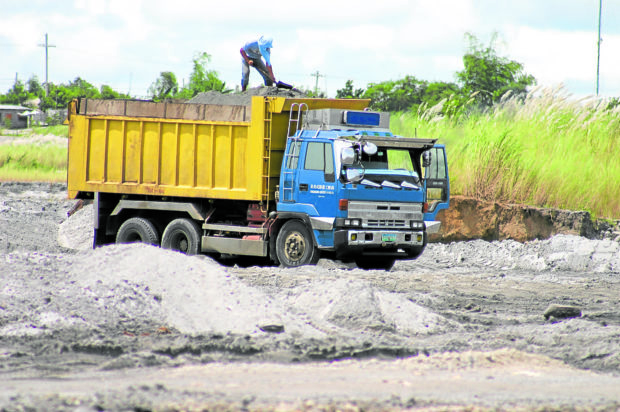
SAND-RICH Rivers in Pampanga province are choked with sand that Mt. Pinatubo spewed out when it erupted in 1991. Quarried and sold to the construction sector, the sand brings billions of pesos to the coffers of local governments. —TONETTE T. OREJAS
CITY OF SAN FERNANDO, Pampanga, Philippines — Higher demands for Mt. Pinatubo’s sand and gravel for construction projects have brought in P82.131 million to the coffers of the Pampanga provincial government in March, surpassing the P72.8-million revenue in February.
The cooperation of quarry operators and sand haulers with the regulations of the provincial government also played a “big key” in attaining the big income, Gov. Dennis Pineda said in a statement on Sunday.
The collection in March increased to P1.118 billion the total revenues earned by the province from sand and gravel miners in the last 20 months, said Charlie Chua, provincial administrator, in the same statement.
Sand became abundant in the province from the tons of volcanic ash spewed by Mt. Pinatubo when it erupted on June 15, 1991, the world’s second largest eruption after the Novarupta eruption in Alaska in 1912.
The quarry revenues came from a sand tax of P150, an administrative fee of P250 and weighing scale fee of P30 that operators and haulers were required to pay to the province, a report obtained by the Inquirer showed.
Fees are also charged for sand and gravel quarry permit and motor vehicle and heavy equipment accreditation, while fines and penalties are imposed on violations, such as overloading.
Good use
Pineda said quarry revenues “went to good use” as it had been spent to acquire two ambulances, food packs for distribution to residents and medical supplies related to addressing the COVID-19 pandemic.
The capitol’s share of 30 percent from the P150 sand tax was primarily spent on controlling the spread of COVID-19 and supporting the treatment of poor patients, Chua added.
In the past, elected Pampanga officials were haled to the Office of the Ombudsman or the National Bureau of Investigation for corruption charges involving the use of the sand and gravel fees. These complaints were eventually dismissed.
Chua said the sand tax was also shared with the villages and towns, or cities, where the sand was extracted, at 40 percent and 30 percent, respectively, as authorized by the Local Government Code of 1991, or Republic Act No. 7160.
Sand and gravel are supplied to construction companies in Luzon, especially in Metro Manila, as filling or mixture materials, according to Romeo Dungca, chief of the quarry unit Kalam.
There were three days in March that P6 million worth of sand was towed daily, figures showed.